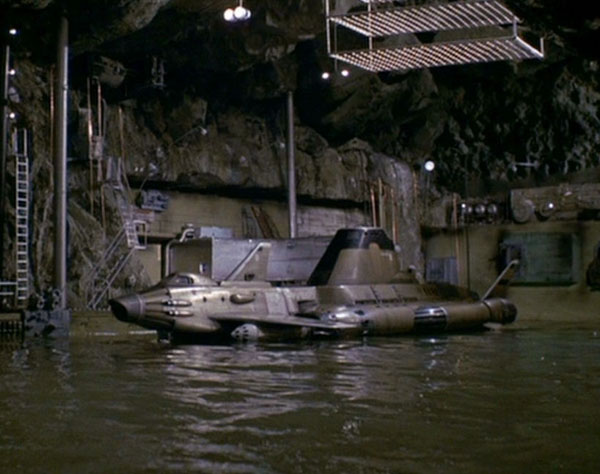



SHADO SkyDiver
Web site by: Phil
Broad
SkyDiver is one of the more original vehicles presented on the TV series "UFO". It is a submarine which is used to convey an advanced manned aerial interceptor to any trouble spot on the high seas without being detected. SkyDiver is capable of operating as a hydrofoil thus allowing great speeds in relatively calm seas. The aircraft portion is called "Sky 1" and the submarine mothership is known as "Diver", thus the overall name "SkyDiver". We never learn how many of these ships are in the SHADO Operations Fleet but there are enough to cover most of the major oceans. The SkyDiver ships are numbered in serial, 1-? (perhaps as many as ten?), 1 through 3 being seen in the show itself. As is true with most science fiction hardware designed for TV the SkyDivers are too small to contain everything seen or implied in the show. In the beginning the ship contained, besides the Sky 1 fighter, a flying bridge, main operations cabin and engine room. Later a "Captain's cabin" was added aft of the main cabin and still later, an anti-room was added between the Capt.'s cabin and the main cabin. This anti-room lead to a side hatch used as an escape device in the episode "Sub Smash". No clue was ever given as to how the "engine room" was reached from the main cabin or where the crew was berthed or fed.
In terms of operational design the SkyDiver is a pretty unlikely ship. Sky 1 would have to be kept as light as possible in order to maximize its airborne performance which means that underwater pressures would crush it. A far more plausible design would have a submarine with an openable hangar from which the fighter would then be launched. A VTOL type of fighter (such as the British Harrier) could then effect a vertical landing into the open bay, whereupon hatches would close and the sub would then be ready for diving once again. In fact there are many, many precedents for just this type of operation found throughout the history of military submarines, beginning in WWI. Nearly every major world navy had such subs. In all cases the aircraft were stored in pressurized canisters with their wings folded. After surfacing, the aircraft would be towed out, wings unfolded and then mounted to a catapult for launch or lowered into the water for takeoff via a built in float. The ultimate expression of this type of arrangement is the WWII Japanese I-400 class submarines. These brutes had two 400 foot long hulls mounted side by side (as the current Russian Typhoon class does) forming a double-width sub with room on deck for a huge pressurized hangar. They carried a specially designed high-performance float plane called the "Serian" which was as fast as most fighters of the day, even with the large float slung underneath. These aircraft had their oil cooling systems linked to the subs system so that the engines would be warm at all times. By eliminating the warm-up procedure in this way, the aircraft could be launched in about ten minutes, greatly reducing the time needed for the sub to stay on the surface therefore minimizing its risk of detection. Each I-400 could carry 4 of these aircraft so when operated as a pack, these subs could launch a formidable air striking force.